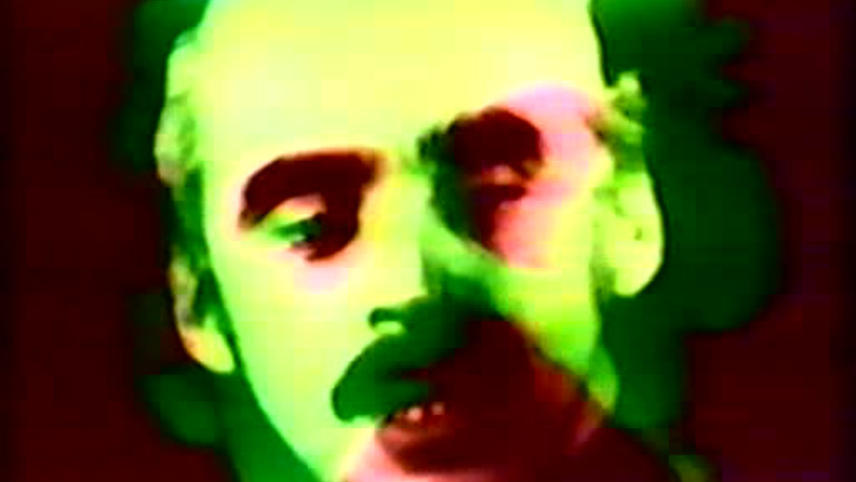
‘As an underground filmmaker and video artist, Jud Yalkut participated in seminal moments of early video art. In 1965 Yalkut became a resident filmmaker for USCO, a countercultural collective. Starting in 1966 and continuing into the 1970’s, he collaborated with Nam June Paik on a series of video-film pieces in which he used the medium of film not merely to document performances, but, through editing and juxtaposition, to create conversations between film and video.’ — Lightcone
‘One of the most influential filmmakers making experimental cinema in New York in the 1960s was Jud Yalkut… Since then, Yalkut has gone on to consolidate an enviable reputation as one of the most important metamedia artists in American independent cinema.’ — Wheeler Winston Dixon, “The Exploding Eye”
‘Jud Yalkut has collaborated in dozens of intermedia performances throughout the United State since 1965, when he became resident filmmaker for USCO at their commune in Garnerville, New York… Yalkut displays a sense of control and orchestration that is the result of working closely with superimpositions within the film frame. Thus in the superimposition of multiple-projection environments he is able to control not only the spatial and temporal dimensions of a performance, but the graphic composition and integrity of the images as well. The result is a ‘film performance’ in the fullest sense.’ — Gene Youngblood, “Expanded Cinema”
‘The work of Jud Yalkut emerged out of the radical, politicized utopianism of the 1960s… Yalkut continues to explore the theme of inner contemplation in ‘Vision Cantos’ (2000), his most recent video installation, whose title reflects the breaking down of boundaries among disciplines that has characterized all his work… Once again, the viewer is encouraged to perceive the projected image as a total experience.’ — Chrissie Iles, Curator, Film and Video, The Whitney Museum of American Art
____
Stills



























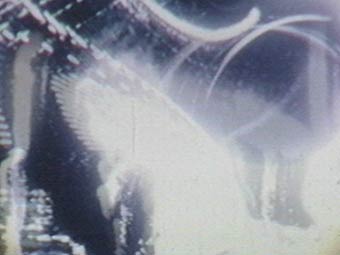
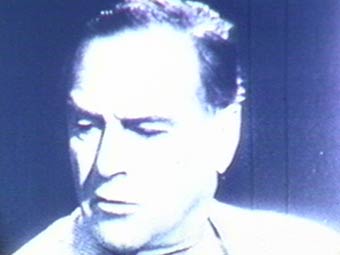

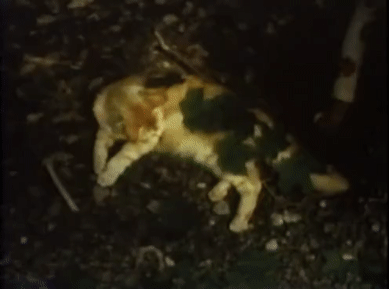





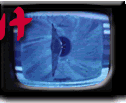


____
Further
Jud Yalkut @ Wikipedia
Electronic Arts Intermix: Jud Yalkut
Jud Yalkut @ IMDb
DREAM REELER: Jud Yalkut (1938-2013)
Film and video artist Jud Yalkut dies at 75
Jud Yalkut @ Filmmakers Coop
Nam June Paik Jud Yalkut – Video Synthesizer and TV Cello Collectibles
Between Film and Video- the Intermedia Art of Jud Yalkut
Imagining Flight – Jud Yalkut
____
Extras
Jud Yalkut on Immersive Environments
Nam June Paik: Art & Process – Jud Yalkut
______
Interview
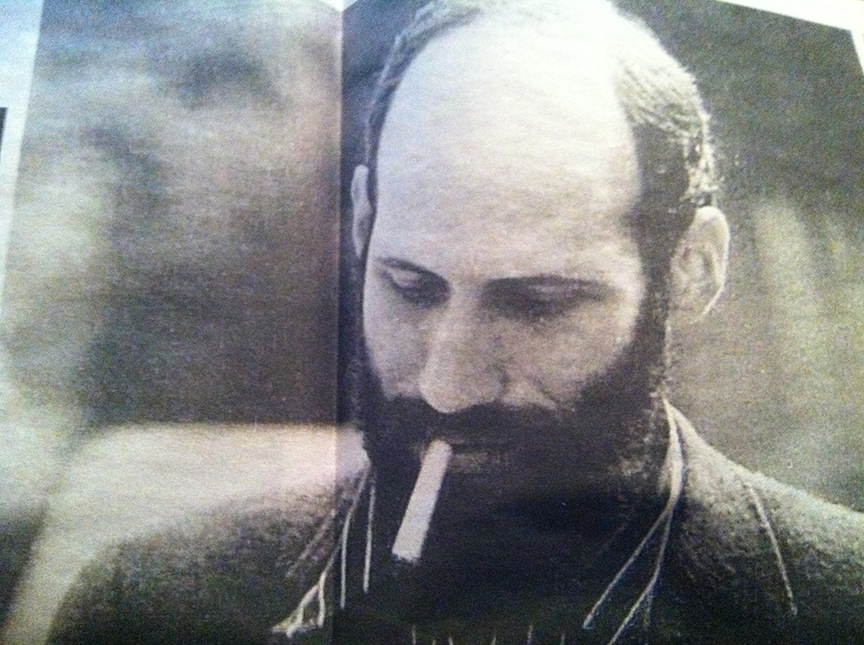
Sabrina Gschwandtner: I thought we could begin by talking about what the Destruct Film at the Judson Gallery – later installed at the Whitney – had in common with your 1967 film, Kusama’s Self-Obliteration.
Jud Yalkut: Actually, there was no connection between them whatsoever. The show at the Whitney in 2000 was media environments by myself, except for the collaborative work that I did with USCO, which was the one with the balloons, spinning around, called “Yin/Yang Sine/Pulse,” and everyone’s contributions to it were equal. Many of the films from the USCO period were shown at the final weekend of the show. The second installation, the Destruct Film, came out of my participation in the “Art and Destruction” movement—I was on the American Committee of Artists for that—which included, among other people, Jon Hendricks, Jean Toche, Al Hansen, Lil Picard, and a number of other people. The “Art and Destruction” movement was an international movement, of course, in England and all over. There was a big show of Destruction Art at the Finch College Museum; a lot of things were going on at that time. The Judson Gallery became one of the venues where that kind of art was explored, and people did a number of things there. There was a series called “Manipulations,” which included Nam June Paik and Charlotte Moorman; there was a very famous, almost infamous moment, when Charlotte was performing this piece by Paik, “One for Violin,” which involved smashing a violin, and she was about to smash it and some artist/activist—I think his name was Saul Goodman, or something like that—stuck his head right into the place where she was going to do this. It was a kind of protest to prevent her from smashing the violin. And what happened in the end was that somehow Charlotte actually completed the action, but he got hurt.
Sabrina: She smashed it on his head?
Jud: Probably. There are a lot of different accounts of that. Also Al Hansen gave a Dada lecture, and there was a painter in the area named Steve Rose, I think—he’s now teaching in Pennsylvania—and his idea was to do an Abstract Expressionist painting as a live performance. Then there was also Jean Toche with his light machines that said, “Do not hurt me, I am a human being,” and lights that were too bright, that hurt your eyes, all these other kinds of things. I filmed a bunch of these things.
Sabrina: So they asked you to be the filmmaker for this?
Jud: Well, I was a friend of all the people there, so there was never a formal asking. I filmed it all on regular 8 mm and left it unslit so that on 16 mm it’s four screens and this film was shown as a continuous loop. The big thing is that Destruct Film was a piece that I designed site-specifically for the Judson Gallery, where as you walked down into the gallery, you walked into a sea of film strewn all over the place; there were some projections, there was a loop of “Some Manipulations” that ran continuously, like feedback, of things that had happened in the space, being projected back into the space, and there were two slide projectors, which had at that time slides from filmstrips that used to have “start” and “end” printed on them, but later the slide projectors showed 35 mm slides that had the standard 35MM countdown on them, and this is the way it was presented at the Whitney. And in front of the lenses of the projectors, I had motorized beam-splitter mirrors, which spun the images around the room. So you had all these light beams going on, with all this film in the middle, and people had to destroy the film by walking on it, sitting on it; people made piles and jumped into it, picked it up and held it into the light, and so forth. The whole thing was based on the idea of film as a strip and a loop; it was a comment on the nature of film in the context of art and destruction.
Sabrina: There seems to be a thematic link between Kusama’s Self-Obliteration and Destruct Film, no?
Jud: Well, only because it happened the same year. I was filming with a choreographer at the Black Gate Theater, and Kusama came in; she was doing something there two weeks later, and she asked me to film it. It was in the beginning of December that I did the Destruct Film, and later in December, I was in Belgium for the Experimental Film Festival where the Kusama film was shown. So they were simultaneous but unrelated in other respects.
Sabrina: So you see the Kusama film as a documentary that you did for her?
Jud: No, not a documentary, it was a film that I wanted to do. I had an interest in film as an experiential medium because I did it environmentally, I did multi-media shows with USCO. Destruct Film became an experiential/environmental thing, and this was an experiential art concept expressed as a film. At the end of the film, one of the things that happened in 1968 was that Kusama started using it to lead into actual naked body painting happenings. But the whole thing is that it moves towards different levels of poetics; well, that was my real interest in doing it.
Sabrina: Poetic…?
Jud: Visual poetry. I was originally a word poet. And I was also a visual artist and I was interested in technology. I majored in math and physics for a year at the City College of New York, and all that merged together in film. So merging art and technology has always been present in my work in film, video, digital, or whatever. I highly enjoy an admixture of film, video, and digital manipulation, and the complex tactilities that this affords me.
Sabrina: What do you mean by tactilities?
Jud: By tactilities, I mean the unique texture which each medium has, whether it is the beautiful reflected light of film, the direct eye-brain projection of electron/photons in video, or the magical iterations of digital delay, feedback,,and electronic coloration. The contrast between “real” color in imagery and the otherworldly richness of electronic color is highly beautiful and fascinating to me, as are the confluence of pixels in digital work, raster lines in video, and grain in film. They each have a unique beauty that cannot be found in other forms.
Sabrina: How has the idea of tactilities evolved over time for you? I remember a mention of the tactile in Jonas Mekas’ diary entries published in an edition of Film Culture that I read recently, in which he writes about Sol Mednick speaking at the Philadelphia College of Art. Mednick said that cinema will probably never have that tactile feeling, the energy passed from a painter’s brush onto a canvas.
Jud: Mednick is referring to what he conceives of as being the “hands-on” feel of the artist and the direct contact with the medium. In filmmaking, the tactility of editing is very direct, with the feel of the film in one’s hands, the smell of the cement, the ability to cut directly to the correct frameline. Filmmakers feel that video lacks this tactility, but in video there is another translation of this hands-on effect in the almost instantaneous reaction of the medium to the maker’s will, which is an experience of another ilk. If a painter could project his vision directly onto a canvas, and with a twist of the mind give the strokes the strength or gentleness required, this might somehow equate to the video artist’s tweaking of the image, producing changes and making choices almost in real time, or as close to it as is humanly possible.
Sabrina: Your film Kusama’s Self-Obliteration seems to translate the tactile experience of the editing and shooting very well—not just because the film features people touching. The camera movements and the intimacy of the shots give a very tactile impression. And your piece Electronic Zen seems to me very much about tactility and energy.
Jud: Electronic Zen was Nam June’s piece, in which the film is clear leader and picks up dirt and scratches and is based very much on the energy of the projection beam into the environment. Self-Obliteration and the process of its shooting involved very much my total immersion in the scene, moving with the camera, creating “body zooms” by choreographing with the camera (I owned no zoom lens at that time and used the “body zoom” in many of my films of the 60s; some people misinterpreted it as “overuse” of the zoom). Also, by involving the camera in the action, there was a new sense of the subject and object merging, which in the case of Self-Obliteration was highly relevant.
Sabrina: Tell me about your first experience with filmmaking. How did you get into it?
Jud: Well, the very first film I made was when I was 13 years old, and I was bar mitzvahed. My present was not a fountain pen, but an 8mm camera, which my father used to film the bar mitzvah. I actually made some films with that camera, and then I got into other things, but I was always interested in film, and I went to films from the time I was 12, and became really conversant in avant-garde and experimental films early on. But, as I say, I became a poet. I went to McGill College in Canada, and Leonard Cohen was my fraternity brother. But when I went to Big Sur in 1957, I stopped writing poetry and stopped doing anything art-related until I moved to the Monterey Peninsula a year later where I started painting again. When I got back to New York much later, in 1961, the woman who became my first wife—a real film buff—gave me an 8 mm camera, and I started making films again. In 1964 I got my first Bolex, and at the end of that year and the beginning of 1965, I started working with the USCO group. It was in 1965 that I started working with Nam June Paik, and the rest is history.
Sabrina: And you worked with him until 1972?
Jud: Well, the Video/Film Concert pieces went up to 1972, but the collaborations continued ever since that time, because I worked with him on a John Cage piece in 1973; there was the Suite 212 that was actually finished when I left New York in 1975, and we still do things together.
Sabrina: I know that you produced a video around the Paik retrospective.
Jud: That was for the touring show, “Electronic Super Highway,” in 1996. I directed that thing, working with the Carl Solway Gallery in Cincinnati where the pieces were actually being fabricated, so that made it easy, because the whole show was there. And then we had someone go out and shoot the first installation in Ft. Lauderdale.
Sabrina: In your Early Color TV Manipulations with Nam June Paik, there is a sense that the energy comes from objectifying the subjects of the video, where you electronically manipulate the video image and destroy the video signal.
Jud: In these early color TV pieces with Paik, he was transforming the video signal through various means, either rewiring the circuits, or throwing in electromagnetic interference, and destroying the video sync signal in the process. I was discovering ways to capture these images on film, since they could not be recorded on video, and then reworking these images through film editing into final pieces. In the Cinema Metaphysique series, one of the techniques I used was a matte box to film only portions of the screen, as we were basing the series on the exploration of the “unsafe” parameters of the film image’s edges when it is translated to TV.
Sabrina: And you used TV in other films.
Jud: Paik and I produced the whole series of video films in the “VideoFilm Concert” program from 1965 through 1972. I have used the video of the Woodstock Festival, transferred to film, and A&B rolled with my original color film to produce Aquarian Rushes. Of course, my ongoing video work involves various aspects of TV at various times, and I have produced works like Raw War, based on TV images of war and destruction, and another based on images from the early history of television, as well as Felix in Videoland based on the fact that an image of Felix the Cat was the first experimental image transmitted from a studio in NY to the Midwest before World War Two.
Sabrina: Tell me a little bit about the filmmaking for USCO.
Jud: There was a commune in Garnersville, New York—which is very close to Stony Point—where Stan VanDerBeek, John Cage, the sculptor Shari Dienes, and a lot of other people were. The church in Garnersville that USCO used as a base is still there; it’s the Intermedia Foundation now.
Sabrina: The term ‘intermedia,’ isn’t used so much right now. How did it come about?
Jud: I wrote an article back in 1966, when I started writing for Arts Magazine, called “Understanding Intermedia,” which was a paraphrase of Marshall McLuhan’s term. The term came about in a number of different ways; no one knows exactly how it was formulated, but some people think it might have been by Dick Higgins, who used it to talk about things that were working between the different art media. So intermedia is the combination of different media working together. Some people called it “multimedia,” but multimedia as a term is totally corrupted by the whole cyber thing. You know, it’s something else and doesn’t have the same meaning anymore.
Sabrina: What’s the difference?
Jud: At the time, intermedia and multimedia were the same thing. It was like talking about avant-garde, experimental, or independent film back then. Today, when you talk about independent film, you’re talking about people who are making feature films outside of Hollywood. It’s different. Multi-media means making things for what they call ‘new media,’ which is, you know, DVDs; it’s when people are going to do a presentation for somebody and they are providing images, word, sound, blah blah blah. And, it’s a totally other thing. People make DVDs and CD-Roms for art, of course. I use DVDs for installation work now. The Whitney USCO installation will be shown in Vienna as DVDs and video projection instead of film loops. I was one of the first and one of the few people who worked with both film and video. There were a handful of us, including Scott Bartlett, Tom Dewitt, Ed Emschwiller, Stan VanDerBeek, and myself. That was it. I interviewed all of them about it; the manuscript for that is up at the Experimental Television Center; it was finished finally with a grant in 1984, from NYSCA. Some of it is on the Vasulka web site; I think it’s also on EAI’s web, and some of it is on the ETC web pages.1 But it’s a 400 page manuscript, called “Electronic Zen: the Alternate Video Generation.”
Sabrina: What sort of questions did you ask people during the interviews?
Jud: Oh, they covered everything–technical, philosophical, social, aesthetic, questions, and so forth.
Sabrina: What do you think of the intermedia approach to ideas of social connectedness now?
Jud: It’s not as prevalent as it was back then. In New York in the 1960s and 1970s, filmmakers, composers, dancers were all overlapping, attending each other’s things. That was the time when my career was really built and there was a lot of collaboration; so my career has always been really involved with that in some form or another. USCO is a notable example; the continuing relationship with Paik is another; the collaboration with Kusama another. There used to be a real community.
____________
9 of Jud Yalkut’s 25 films
____________
Us Down By The Riverside (1966)
‘USCO light, Beatles sound. A visionary realization of the USCO Riverside Museum installation exhibition in New York, the show which introduced the word ‘Be-In’ to the English language. Premiered by National Educational Television on Channel 13, WNET-TV, New York’s first “Wednesday Magazine” program. Selection (with “Turn Turn Turn) for the Second Tokyo Underground Film Festival; Hors de Concours screenings (also with “Turn Turn Turn”) at the Fourth International Experimental Film Competition in Belgium.’ — Filmmakers Coop
the entire film
____________
Turn! Turn! Turn! (1966)
‘Turn, Turn, Turn (1966) is a collaboration between Jud Yalkut (visuals) and the Us Company aka USCO (sound). The latter receive several mentions in Chapman’s detailing of the early psych scene in San Francisco in the mid-60s; here they put a Byrds song through the mangler while Yalkut’s mechanical and other effects flicker and gyrate. The visuals are reminiscent in places of the film made by László Moholy-Nagy of his Light-Space Modulator, fittingly so when Chapman credits Moholy-Nagy’s machine with being one of the many forerunners of psychedelia in the art movements of the early 20th century.’ — John Coulthart
the entire film
_____________
The Godz (1966)
‘Document of 1960’s rock-and-roll cult band “The Godz.” Contains footage of a few mid-60’s performances as well as candid footage of the band.’ — Filmmakers Coop
the entire film
_______________
Kusama’s Self-Obliteration (1967)
‘Yayoi Kusama’s art has often been classed as psychedelic—some of her mirrored rooms were featured in the travelling Summer of Love exhibition in 2005—but this is more a consequence of her activities meshing with the interests of the late 60s than anything else; her preoccupations always seem a lot more personal and obsessive. Jud Yalkut’s short film shows Kusama and various friends cavorting in typical underground-movie fashion in 1967, the main indicator of the artist’s involvement being her sticking polka dots (and leaves) onto everything: trees, people, cats, horses, even a river. Later on there’s more polka-dotting at some kind of body-paint happening inside one of her mirrored rooms. The film itself is pretty psychedelic in the second half, looking like outtakes from Roger Corman’s The Trip. The of-the-moment score was provided by The CIA Change, whoever they were.’ — John Coulthart
the entire film
______________
Destruct Film (1967)
‘In Destruct Film, viewers walk over reams of unspooled film strewn across the floor, shifting the experience of film into a tactile encounter.’ — The Whitney
Excerpt
_______________
w/ Nam June Paik Beatles Electronique (1966-69)
‘This is an interesting pioneering piece of work in video art realized in 1969 by Jud Yalkut and Nam June Paik. The authors take filmed and sound extracts from a Beatles concert, as well as the visual rendition of the concert sound on the monitors of the recording equipment, process the images and the sound to create something new and different. Original soundtrack: “Four Loops” by Kenneth Werner. “BEATLES ELECTRONIQUES was shot in black-and-white from live broadcasts of the Beatles while Paik electromagnetically improvised distortions on the receiver, and also from videotaped material produced during a series of experiments with filming off the monitor of a Sony videotape recorder. The film is three minutes long and is accompanied by an electronic soundtrack by composer Ken Werner, called ‘Four Loops,’ derived from four electronically altered loops of Beatles sound material.’ — artelectronicmedia.com
the entire film
_______________
w/ Nam June Paik Waiting for Commercials (1966 – 1972)
‘Waiting for Commercials is a hilarious compendium of Japanese TV commercials. This early example of Yalkut and Paik’s use of appropriated television imagery as pop cultural artifact was originally created for a performance piece of the same name, which featured Charlotte Moorman and her cello.’ — EAI
the entire film
___________
Planes (1972)
‘For Trisha Brown. Dancer: Simone Forti. Sound: “Vacuum and Voice” by Simone Forti. With thanks to Jill Johnston, Les Levine, Walter Gutman, and the New York State Council on the Arts. PLANES is an exploration.’ — Filmmakers Coop
Excerpt
_____________
Light Display: Color (2002)
‘LIGHT DISPLAY: COLOR is the culmination of several years of development of analogue and digital images derived from original 16mm footage shot of the first working reconstruction of Laszlo Moholy-Nagy’s pioneering kinetic sculpture LIGHT DISPLAY MACHINE, or LICHTEQUILST, first shown at the International Building Exhibition in Paris in 1939. Moholy had designed the sculpture, both to exist as itself, and to be the subject of a projected six-part film called LIGHT DISPLAY, BLACK, WHITE, GRAY, of which only the sixth section featuring the Light Display Machine was finished. In the early 1970’s Moholy’s wife Sibyl worked with several engineers on a working reconstruction of the machinem, which was exhibited at the Howard Wise Gallery in New York City.’ — J.Y.
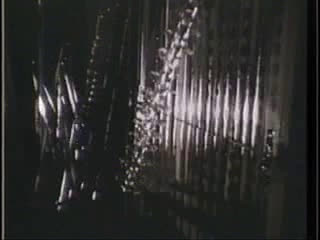
*
p.s. Hey. ** Misanthrope, Hi. Okay, well, you sound like you’re thinking very straight about it. Straight in the good way. He needs to know he’s not invulnerable, and if being told that and endlessly reminded isn’t the solution, there’s really no other solution than to remove the guard rails or whatever. Tough love, or whatever they say. Jeez, sorry, man. He seemed like a good guy when I met him, and I hope he learns to prioritise that side. I say go full on for the lawsuit. It sounds like you really have a case. I hope your weekend had some big ups in store. ** David Ehrenstein, Thank you for the great response to James and his book! ** Kyler, Hi, man. ** Steve Erickson, I liked what I’ve tried of the van Etten. I’m not sure I’m in its mood. I am very curious about Malkmus’s electronic record. I’m glad Matador finally green lit it. Did you get the gruelling weather? I didn’t see anything on the news about it, so I’m guessing if it was hard it was fairly normally hard. Your words on the Godard at last. Everyone, Mr. Erickson has reviewed the new Godard film ‘Image Book’, and can you resist? You shouldn’t. Here. Yes, I saw it, It was right near/at the top of my fave 2018 films list. ** Keatspeak, Up? The usual with slight variations, I guess I could say. Cold here, and possible snow tomorrow through Thursday, which of course I would largely miss since I’ll mostly be in London, where I suppose it could snow, but snow on a vacation spot is not the same. Novel going great? That’s GbV to my ears. Eyes too. Matt? No one particular springs to mind, so which Matt do you mean? No, didn’t see that about AIC’s movie. I’ll hunt the joints that would consider that news. I hope the panties parted like the Red Sea. Without too much redness. Love, me. ** James, Hi. Cool, i.e. you and ‘PGL’ being squared away. I don’t think I know Pacifica. At least by name. I’ll look it up. Cool that your other half likes ‘GJr.’ Is that my only non-scary novel? ‘MLT’ isn’t that scary. Well, differently scary. Anyway, I’m happy a piece of mine is conquering him. I’m not sure if he’s going to SF, but he can probably handle ‘PGL’ if he is. Love, me. ** _Black_Acrylic, Hi, B. Yes, the new David Keenan novel is at the top of my list. I’m planning to pick it up while I’m in London, in fact. ** Nik, Hi, man. It’s going okay, quite busy bordering on about to get really busy, but it’s all good busyness. Thank you very much about the gif work. Means a lot. The producers’ feedback on the script was mostly very irksome and showed they don’t really get what we’re doing, which is not unexpected, but they agreed to send it off to ARTE as is, and that’s all we were hoping for. So ARTE has it now, and we’ll likely learn what they think in three weeks or so, gulp. Okay, as I haven’t yet checked out the emperor x, I’ll start with those suggested songs, thank you. Very happy to see you use ‘pretty good’ about how your writing’s going. The unnaturalness can lead to great things, in my experience. There’s always something of yours in there, and going what seems to be astray is never really going astray. It just requires a particular kind of study, I think. If that makes any sense. Um, yes, of course that’s the case in my tackling of, say, gif fiction or the film work. But I suppose I always primarily think of those quests like a writer. As I’ve said, I think the gif novels are novels in every respect other than the change in their surfaces. Sure, I would love to read your piece. I’ll just forewarn you that I’ll have to find the time, and I’ll do my very best. I’m about to head to London to show ‘PGL’ and then off to the West Coast shortly thereafter for two-plus weeks to do the same, but, yeah, let me see it, and I’ll do my utmost to devote time to it. This week: a bunch of ‘PGL’ stuff as we have to make a new poster and trailer for the French release and then two days in London, and then more ‘PGL’ work and seeing a couple of theater things — Christophe Honore’s new play and a play starring Benjamin, our lead actor in ‘PGL’ — and getting ready for the West Coast trip. Pretty bunched up week for me. I hope yours goes extremely well. ** Bill, Hi, Bill. Cool that ‘PGL’ is at the header of the deluge. Yeah, I felt similarly about ‘Evolution’. I like her and what she’s doing, but I wish she was less interested in being wilfully obscure because I think that’s less mysterious in her case than it is trope-y ultimately. ** Sypha, Thank you so much for being such a great and responsive host, man. It was a great and very trafficked weekend, and I thank you again so much! ** Okay. I’m guessing that the great majority of you don’t know Jud Yalkut’s films, although perhaps I’m wrong. He’s best known, if he is known, for his terrific early film about Yayoi Kusama, but there’s a lot else of his that’s very interesting. Do explore the post, if you will. See you tomorrow.




 Now available in North America
Now available in North America 
My but Jud Yalkut is a welcome Blast From the Past!
It’s Martin Luther King’s Birthday so here’s Laura Nyro
Thank you David. I’m so in love again with Laura. Saw her at the Fillmore East, first row. And quoted that song in my high school yearbook. Gives meaning to this day!
Great Stuff On Gary !
The storm over the weekend didn’t amount to more than 12 hours of fairly normal rain. But extreme weather has hit New York at last. It was 4 degrees (F) when I woke up. It’s also very windy, so going outside is unbearable. It’s so cold in my apt. now that I’m typing this underneath a blanket. But tomorrow will take us back to the 20s.
Anthology has played Yalkut films a few times, especially the music-related ones, but I’ve missed them. I plan to catch up with a few here today.
At least your producers were willing to send the script off to Arte with no interference.
For reasons that are probably obvious (the incident with MAGA boy Saturday), discourse on social media seemed to reach a new low over the weekend. I saw friends getting into detailed arguments over completely petty crap, like “How can you be a conservative while having a photo of George Carlin as your avatar?” And while I didn’t get into an argument over that, I did waste time getting into a verbal screaming match with a TERF and felt completely empty and drained afterwards.
Dennis, Thanks for the intro to a totally new filmmaker for me. As usual, right?
Yeah, LPS is a very pleasant individual. What you saw in NYC is how he is 99% of the time…and then he does really dumb shit. I guess if you’d gotten to talking to him more about things, you’d probably have seen that, while pleasant, he has some odd ways of looking at things. I think a lot of it is to do with his chronic weed use but probably even more so allowing himself to be influenced by people and things that don’t have his best interest in mind. Really -and Kayla and I talked about this this morning- his behavior is very similar to his mother’s. He doesn’t see that, of course. Maybe he will some day. There’s always hope.
Well, I got to watch some football, which was fun. Watched some TV. Got some good writing done last night, with more to follow tonight. Been listening to some music too. I’m kind of obsessed with this song called “Glory” by Cold Cave that Mieze introduced me too. It just really appeals to me in so many ways. So yeah, good weekend all in all. No complaints.
It’s 20 degrees here today. I’m staying inside. A good day to do a lot of indoor stuff. 😀
Hey Dennis – Excited by this Jud Kalkut Day. I knew his name, but nothing about the work. I’ll dive into it over the next few days. And wonderful weekend post about “Harlem Smoke” making its debut in the world.
Do you have any interest in a guest post about the newly translated Roussel stories published by The Song Cave? They’d love to have something here about the book and can put together some exclusive excerpts and other intriguing content, if you’re into it? Let me know. If so, I’m happy to help make it happen.
Glad the tv script is off to Arte and hope they have a much better reaction to the new version than the producers.
Speaking of Arte (in an earlier and more artist friendly incarnation?), have you seen the 14-episode Chris Marker tv series ‘The Owl’s Legacy’? Finally released on DVD and maybe streaming too?
Thanks for checking out my Bookworm episode. Glad you liked it. Michael had a very specific way he wanted to talk about DAM, which was fine by me and very perceptive, but also a bit dizzying in terms of how the conversation hopped. Are you planning to see him on your California trip?
Hi!!
I’m good too, thanks. The new issue of SCAB is shaping up nicely. I started reading The Pale King by David Foster Wallace (this is my first Wallace book, I haven’t read Infinite Jest just yet) – it’s completely different from what I expected, so much better. I mean, I did expect it to be quite brilliant just, for some reason, not entirely for me. But it is.
Did the new ‘PGL’-related work mostly eat your weekend? Did you finish the poster and the trailer?
Have a safe and amazing trip to London!! When do you come back?
Take care, Dennis!!
Happy to make Jud Yalkut’s acquaintance, I was always a fan of his Kusama doc but never explored further until today.
Dunno if you saw this from Paris men’s fashion week, it’s Kim Jones for Dior – a hand-beaded shirt with Mona Lisa artwork by Raymond Pettibon that took 15 people 1,600 hours to make.
Hey Dennis – hi back. Wish I could be in London on Wednesday – would love to see PGL again, but definitely will – on DVD soon I think? I wish I’d known about Sarah Kane’s production of “Cleansed” at the National Theatre last year. I might have made a trip to see that. My favorite play of hers, I saw the last preview of it originally. How wonderful to live where you are and being able to pop off to London and all places around there…I envy that. Lucky you.
yakult in NZ is a brand of probiotic milk which is what i assumed this post might be about the creator of or something, now i have stuff to explore!
Hey D.,
I think my mom has a picture somewhere of her with Nam June Paik while she was in grad school and pregnant with me, haha. I really like the collaborations this guy did with him. I also love his experiments with live performance. Cool, thanks for sharing.
Glad you’re finally getting some good busyness going on. I feel like I’ve wrote this a billion times, but, yeah, for the billionth time, ‘ugh’ at the producers totally not getting your show. Especially after making it more conventional for them, sheesh. They sent it off anyway though, cool, congrats. Tell me what they say when they get back to ya.
Yeah, ‘pretty good’ is how writings going, it’s all a lot of editing and altering already written stuff, which feels like it’s coming to an end at this point. I think I have a way to tie these stories together, cuz there’s a lot of overlapping themes and narratives, but I’m not sure in what way yet. Hopefully the class with Ann Lauterbach next semester is a boon for writing in a different way, and I can let the idea of combining and/or connecting stories take the backseat into daydream territory, where I think it needs to be right now, probably.
Oh, that’s a relief about the unnaturalness thing being a potentially good thing. That’s totally where I’ve been the last few months and it’s been a weird, doubtful, but sometimes productive experience. “a particular kind of study” doesn’t make total sense to me, but I think I see what you’re getting at. Thank you, it’s a big help to hear that kind of stuff.
Wow, yeah, that’s a really tight schedule. Thank you for wanting to read it though, that means a ton! Should I send it to your hotmail? I had no idea Honore had a new / wrote plays. Hope the busyness inspires a spring of energy rather than travel fatigue!!
Watched the Beatles stuff. Raw reaction was it seemed “ahead of its time” but I really can’t stand that phrase.
“Destruct Film” reminds me of when I did spill training as an apprentice 35mm projectionist. If it’s not an archival print you just let the film spill out of the projector in a somewhat controlled way so the audience can’t tell there’s a problem, then clean everything up in time for the next changeover.
I’ve been especially enjoying the posts lately, thanks. Sypha, I really liked what you did with location scouting photos for a novel. I’d be interested to see more novelists do that sort of thing as an online supplement to their books.
Over the weekend I set a goal of starting film school at Tel Aviv University in fall of 2020. I’d originally thought about starting to study this fall, and tried to fool myself into thinking I’d study something more lucrative. I could wrangle my way in this fall but I’d be just barely qualifying with my Hebrew, and I’d rather start from a position of strength with near-native Hebrew and some independent study ahead of time. It’s just that I got burned by a BA in English that was a triple whammy of not being enjoyable, not leading to a new job, and costing a fortune.
I still have an irrational fear of school turning everything it touches into drudgery, but I guess it’s all about the student’s attitude. At least university is dirt cheap here by USA standards and I could definitely support myself while studying with my current set of gigs and/or some other possibilities. I just try to tell myself that even at 30 I could put my best effort into filmmaking for 5 years and then if it really goes nowhere study something more lucrative afterwards.
I’m in a for me weird place as a reader. I pretty much don’t crack open any books besides a book of Hebrew poetry by an out of print poet who’s been dead for almost 30 years. It’s like I’m channeling or something. Have you ever had experiences like that?
Before I put a lid on my rambling on about myself I have to mention that patience is paying off on the poetry scene here and I’m ready to submit a few poems to the editor of a zine whom I’ve gotten to know. I hope writing about it here will get me to actually send them in this week because while there’s no official deadline I’m sure the sooner the better.